» posted on Sunday, December 20th, 2020 by Linda Lou Burton
Mah-za-yan-ic Shortcut and My Ed-u-kay-ted Brain
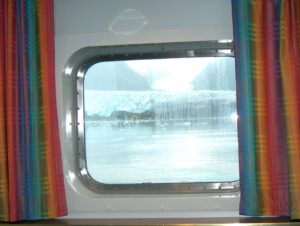 Christmas in Antarctica originally posted by Linda Lou Burton December 20, 2005 from Strait of Magellan, Chile – The alarm went off and I jumped out of bed and peered out the bigger-than-a-porthole window. A chunk of ice went floating by. We were 15 minutes away from the announced destination time at the Skua Glacier, so I splashed cold water on my face and threw on yesterday’s clothes. Two cameras in hand, I headed for Deck 7.
Christmas in Antarctica originally posted by Linda Lou Burton December 20, 2005 from Strait of Magellan, Chile – The alarm went off and I jumped out of bed and peered out the bigger-than-a-porthole window. A chunk of ice went floating by. We were 15 minutes away from the announced destination time at the Skua Glacier, so I splashed cold water on my face and threw on yesterday’s clothes. Two cameras in hand, I headed for Deck 7.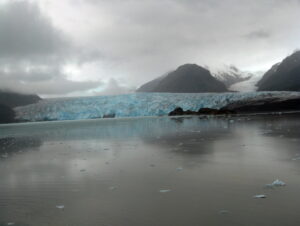
It was cold but not uncomfortable, and a small crowd was gathering, with, like me, cameras in hand. I could see it ahead, at the head of the tiny fjord, a blue glow coming into the sea. Our info described it as picturesque. That it was. I leaned against the rail in the frosty mist and did my photographing thing. Glaciers are blue because the ice is so dense the air has been forced out of them, I’m told. The ship spun three times, slowly, so that even the lazyheads who didn’t want to leave the warmth of their cabins could see. And then we moved out of the fjord and on to Amalia Sound.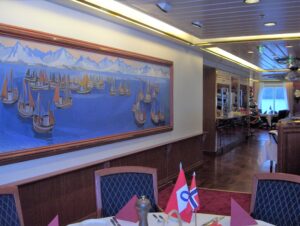
I was catching on to the ship’s routine now. Breakfast. Lectures. Relax by the windows. Watch the world float by, today, still misty with fog. Crepes for breakfast, lots of coffee. A lecture at 9:30 on Patagonia and Tierra del Fuego by Dr Fanz Gingele in Kapp Horn Hall. The Germans have Michael Theusner speaking about Antarktische Wetter and Klima in Nordkapp Hall at the same time.
We have a good lecture staff. Our Expedition Leader is Ian Michael Shaw, Canadian, a youngish, humorous guy, whose credentials claim he “has been beaten up by monkeys on Gibraltar, lived in a Taoist Temple, broken into a Top Secret Naval Base in Vladivostok, tattooed in Tahiti, and sunburned in Brazil.” He also claims to have eaten breakfast in the eye of a hurricane, not such an unusual feat in the minds of Gulf Coast residents of the US, I’d say. He has led expeditions in Russia, Greenland, Polynesia, the Amazon, and in and out of fjords, north and south. Every day, he studies the weather conditions, considers the ship speed, and tunes into world events that might affect anything ahead, before settling on an itinerary for the next day. Then at 6 PM we are invited into the Torghatten Salong (that means Observation Lounge, or Panoramic Room, by the way) for a briefing on what to expect. “Even so,” he warns, “everything is subject to change due to operational or climactic reasons, or Force Majeur.”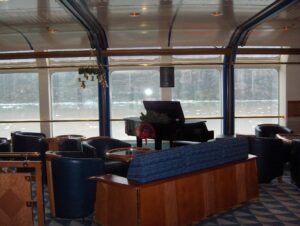
Today, we were to expect two things: the Skua Glacier in the morning (check), and entry into the Strait of Magellan about 5:30 in the evening. We should wake up on Wednesday in Punta Arenas, he advised.
What do you know about the Strait of Magellan? You probably remember from your social studies and geography classes that Mr Magellan came across a more sheltered body of water at the tip of South America than what the ships would have to endure by going all the way around the outer islands – a sort of nature-made Panama Canal. However, many of the largest sailing ships could not maneuver in the narrower, less windy waters. The rugged, mountainous area through which Estrecho de Magallenes passes, remote from the rest of the country, is called Magallenes (Mah-za-yan-es, for the Spanish sound).
I can see this on my map: Cabo Froward, in the Strait, is, officially, the Southernmost Point on the South American mainland. We’re due to pass that spot around 3 AM tomorrow morning. All the other famous markers are on islands!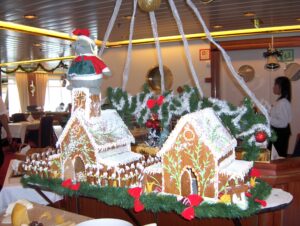
Other items fitted around Breakfast, Lunch, and Dinner today:
- 10:30 Penguins: Those from the Other Side
- 15:00 Krill and the Antarctic Food Chain
- 16:30 A Brief History of Antarctic Exploration 1772-2003
- 21:00 Film: On the Icy Edge of the World
I say mate, me brain is get-in a bit wrinkled, now!
